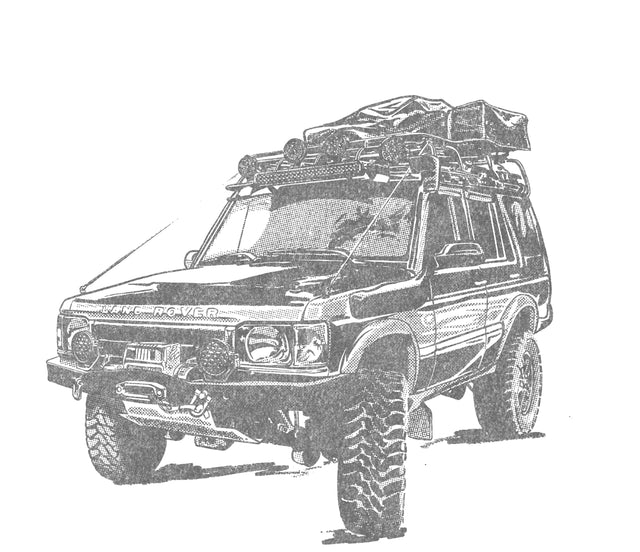Land Rover Discovery - Welcome to the Stable: The Discovery Series I and II
Land Rover introduced the first in the Discovery series in 1989 as its entry into the medium to large premium SUV market. The Discovery, sometimes referred to as "Disco," marked the first new model series since the launch of the 1970 Range Rover on which it was based, and it became only the third new product line since the conception of the Land Rover by Rover in 1948.
Although the Range Rover had originally been designed as an everyday four-wheel drive car adept as both a utility vehicle and a family car, it evolved into a luxury vehicle. The Discovery was intended to fulfill the role the Range Rover originally was intended for – a true off-road family car.
Although positioned below the Range Rover in the company's line-up, the vehicle was both longer and higher, offered more room in the back, and also more seating. Space utilization became more sophisticated in later versions, while still offering seats for seven occupants. Later Discovery generations followed the Range Rover’s lead into the luxury SUV market.
First Generation Discovery 1 (1989–1998)
The Discovery Series I made its debut during the 1989 Frankfurt Motor Show and in October of that year to the market in the United Kingdom. Developed under the internal code-name "Project Jay," the new model used the same chassis, suspension and 4WD-system, and a derivative body design – especially the four-door as the Range Rover. Thanks to modifications such as a smaller engine and two side doors, the early more affordably priced Discovery lent itself nicely to a larger, more middle-class market segment.
The original transmission came as a dual-ratio five-speed manual with drive via a transfer case with a lockable center differential, and was the only one available with a four-cylinder petrol engine until 2017.
Discovery’s Distinctive Style
The Series I Discovery launched only as a three-door model and remains the only model offered as such. The five-door version following in 1990. Both versions came with five seats, with an optional two jump seats fitted in the rear. To make room for the optional third row jump seats, the spare wheel moved to the outside of the car, fitted to a side-swinging rear door, instead of the Range Rover's split tailgate. The raised roof of the rear section created the headroom for the third row. Combined with a safari side window cluster, this gave the Discovery its distinctive profile and style.
Land Rover brought in external consulting firm, Conran Design Group, to design an interior that would incorporate original features with new elements to help position the vehicle as a 'lifestyle accessory'. Their interior design was unveiled to critical acclaim and won a British Design Award in 1989.
The initial trim came only in light 'Sonar Blue' upholstery and plastic, regardless of exterior color. The design integrated a mix of lifestyle details, including magazine holders above the windscreen, remote radio controls on the instrument cluster and twin removable sunroof panels. A Land Rover-branded fabric storage pouch in the front center console could be removed and worn as a handbag strap (few of these pouches survive, making them collectable items).
The Discovery borrowed from many of the interior and dashboard components of other Rover Group models such as the Maestro, Montego and the Rover 800. It utilized several Range Rover body panels and retained the distinctive Morris Marina door handles. The taillights taken from the Austin Maestro van would continue to bear the Austin Rover 'chevron' logo on their lenses until production of the first-generation Discovery ended in 1998, ten years after Austin Rover ceased to exist.
In 1992, the Discovery expanded its interior color selection to include a more traditional beige and added several exterior color options. An automatic gearbox became available on 200Tdi models, and the large 'compass and mountain' side decals worn by early Discoveries to disguise wavy panel fit around the rear three quarter windows was eliminated. The 'SE' pack incorporated alloy wheels, front driving lights, roof bars and a special range of metallic paints. Land Rover Special Vehicles later offered a two-seater, three-door Discovery Commercial version lacking rear-side windows.
Before 1994, the Discovery came with either the 2.5-litre 200 Tdi engine or the 3.5-litre Rover V8. Early V8 engines used a twin SU carburetor system, switching to Lucas 14CUX fuel injection in 1990. Intended to attract fleet managers, since both UK and Italian tax laws benefitted vehicles under 2.0 litres , a 2.0-litre petrol engine from the Rover stable became available briefly in a model known as the 2.0-litre Mpi I4. A combination of changes in taxation and lack of power for such a heavy vehicle led this engine’s elimination, despite having been fitted to several Discoveries supplied to the British Royal family (one of these which Prince Philip drove around Windsor Great Park, in his position as Park Ranger). The transmission came as a permanent four-wheel drive system, with a high and low range transfer box.
In April 1991, the Series I launched in Australia, available as a three-door, 3.5-litre V8i with 115 kW (154 hp) and 260 N⋅m (190 lb⋅ft) and coupled with a five-speed manual gearbox. That fall, Land Rover launched the five-door body variant in base V8i and the luxury HL versions. The Tdi engine became available, rated at 83 kW (111 hp) and 265 N⋅m (195 lb⋅ft). In early-1993, a four-speed automatic option was added to the Australian range and the HL was discontinued.
The Next Generation: Discovery Series II (L318; 1998–2004)
Land Rover debuted the Series II Discovery in autumn 1998. As with any generational adaptation, some traits remained while others changed. The new model continued the 100 in (2,540 mm) wheelbase frame and rigid, live front and rear axles of the original Range Rover into 2004. Land Rover touted 720 'differences', including modifications to the interior and exterior to be less utilitarian, although visible through lines could still be noted from the Series I.
The extended rear body improved load space, which could now accommodate full-size adults on all seven seats on the SE7 option. The change to make the back row forward-facing came at the expense of added rear overhang, which slightly reduced the car's departure angle when off-roading.
The Series II was the last Land Rover vehicle to evolve from the original 1970 Range Rover underpinnings with its extended, 185 in (4.70 m) long, four-door body still riding on a similar, relatively short 100 in (2,540 mm) wheelbase, ladder-frame chassis and combined front and rear live axles.
Changes to the diesel models, including the 2,495 cc Td5 (in-line direct-injected straight-five engine), brought it in line with the updated Defender models. This electronically managed engine made it smoother and produced more usable torque at lower revs than its 300Tdi predecessor. While often mistaken to have come from BMW, the Td5 engine has its origins in the Rover L-series passenger car engine.
The Range Rover P38 Thor 4.0-litre Rover-derived V8 replaced the 3,948 cc V8 petrol version from the Series I. Although similar in basic engine design, it differed internally: it used a different crankshaft, had larger bearing journals with cross bolted caps, different connecting rods, and different pistons. The blocks were machined differently to accept extra sensors for the Gems and Bosch (Thor) injection system and to allow the extra stroke of the 4.6 crankshaft. For the 2003 and 2004 model years, Discovery II changed to the 4.6-litre V8 (though the 4.0 continued as the only V8 option offered in the UK).
ACE (Active Cornering Enhancement), an electronically controlled hydraulic anti-roll bar system) came in some versions to reduce cornering roll. The ACE system could counteract up 1 g of lateral acceleration in less than a tenth of a second, improving the vehicle’s stability and responsiveness during hard cornering. Self-levelling air springs were fitted to some models and European type-approval for seven-seat vehicles was only given to air-sprung examples.
The updated models could easily be identified by new "pocketed" headlamps (which matched the Range Rover and facelifted Freelander models) as well as redesigned turn and brake lamps on the rear of the vehicle. The indicators were moved from the bumper to the high side fixtures. Earlier Series II models could be distinguished from the original Discovery by the position of the stop light fixtures above the window-line (earlier models had them below), and by the change in door handles. The Series II also differs slightly in dimensions.
In the Discovery II’s final production run, only two models were offered for sale in the UK market: the 'base' Pursuit, which retained a high level of equipment as standard, and the top specification Landmark, which offered an all-leather interior, twin sunroofs, Active Cornering Enhancement, six-disc CD player, and a heated windscreen. The final vehicles left the production lines in late-May 2004 to make way for the Discovery 3 (LR3) models.
Rig illustration reference credit: @Leo.steg

